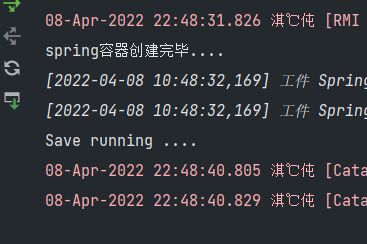Spring与Web环境集成 1. ApplicationContext应用上下文获取方式 应用上下文对象是通过 new ClassPathXmlApplicationContext(Spring配置文件) 方式获取的,但是每次从容器中获取Bean时都要编写 new ClassPat
1. ApplicationContext应用上下文获取方式
应用上下文对象是通过 new ClassPathXmlApplicationContext(Spring配置文件) 方式获取的,但是每次从容器中获取Bean时都要编写 new ClassPathXmlApplicationContext(Spring配置文件),这样的弊端是配置文件加载多次,应用上下文对象创建多次。
在Web项目中,可以使用ServletContextLIstener监听Web应用的启动,我们可以在Web应用启动时,就加载Spring的配置文件,创建应用上下文对象ApplicationContext,再将其存储到最大的域servletContext域中,这样就可以在任意位置获取应用上下文ApplicationContext对象。
2. 创建案例
1、创建监听器
package com.ntect.listener; import org.springframework.context.ApplicationContext; import org.springframework.context.support.ClassPathXmlApplicationContext; import javax.servlet.ServletContext; import javax.servlet.ServletContextEvent; import javax.servlet.ServletContextListener; public class ContextLoaderListener implements ServletContextListener { public void contextInitialized(ServletContextEvent sce) { ServletContext servletContext = sce.getServletContext(); //读取web.xml中的全局参数 String contextConfigLocation = servletContext.getInitParameter("contextConfigLocation"); ApplicationContext app = new ClassPathXmlApplicationContext(contextConfigLocation); //将Spring的应用上下文对象存储到ServletContext域中 servletContext.setAttribute("app",app); System.out.println("spring容器创建完毕...."); } public void contextDestroyed(ServletContextEvent sce) { } }
2、创建获取applicationContext对象的工具类
package com.ntect.listener;
import org.springframework.context.ApplicationContext;
import javax.servlet.ServletContext;
public class WebApplicationContextUtils {
public static ApplicationContext getWebApplicationContext(ServletContext servletContext) {
return (ApplicationContext)servletContext.getAttribute("app");
}
}
3、创建servlet的测试类
package com.ntect.web;
import com.ntect.listener.WebApplicationContextUtils;
import com.ntect.service.UserService;
import org.springframework.context.ApplicationContext;
import org.springframework.context.support.ClassPathXmlApplicationContext;
import javax.servlet.ServletContext;
import javax.servlet.ServletException;
import javax.servlet.http.HttpServlet;
import javax.servlet.http.HttpServletRequest;
import javax.servlet.http.HttpServletResponse;
import java.io.IOException;
public class UserServlet extends HttpServlet {
@Override
protected void doGet(HttpServletRequest req, HttpServletResponse resp) throws ServletException, IOException {
//ApplicationContext app = new ClassPathXmlApplicationContext("applicationContext.xml");
ServletContext servletContext = this.getServletContext();
//ApplicationContext app = (ApplicationContext) servletContext.getAttribute("app");
ApplicationContext app = WebApplicationContextUtils.getWebApplicationContext(servletContext);
UserService userService = app.getBean(UserService.class);
userService.save();
}
}
4、配置web.xml文件
<?xml version="1.0" encoding="UTF-8"?>
<web-app xmlns="http://xmlns.jcp.org/xml/ns/javaee"
xmlns:xsi="http://www.w3.org/2001/XMLSchema-instance"
xsi:schemaLocation="http://xmlns.jcp.org/xml/ns/javaee http://xmlns.jcp.org/xml/ns/javaee/web-app_4_0.xsd"
version="4.0">
<!-- 全局初始化参数-->
<context-param>
<param-name>contextConfigLocation</param-name>
<param-value>applicationContext.xml</param-value>
</context-param>
<!-- 配置监听器-->
<listener>
<listener-class>com.ntect.listener.ContextLoaderListener</listener-class>
</listener>
<!-- 配置测试用的servlet-->
<servlet>
<servlet-name>UserServlet</servlet-name>
<servlet-class>com.ntect.web.UserServlet</servlet-class>
</servlet>
<servlet-mapping>
<servlet-name>UserServlet</servlet-name>
<url-pattern>/userServlet</url-pattern>
</servlet-mapping>
</web-app>
5、测试
浏览器访问
http://localhost:8080/userServlet
控制台输出

3. Spring提供获取应用上下文的工具
上面地分析只是为了方便理解,不用手动实现,Spring提供了一个监听器ContextLoaderListener就是对上述功能的封装,该监听器内部加载Spring配置文件,创建应用上下文对象,并存储到ServletContext域中,提供了一个客户端工具WebApplicationContextUtils获取应用上下文对象。
需要做两件事:
1、在web.xml中配置ContextLoaderListener监听器(导入spring-web坐标)
2、使用WebApplicationContextUtils获得应用上下文对象ApplicationContext
3.1 导入Spring集成web的坐标
<dependency>
<groupId>org.springframework</groupId>
<artifactId>spring-web</artifactId>
<version>5.3.16</version>
</dependency>
3.2 配置ContextLoaderListener监听器
<!-- 全局初始化参数-->
<context-param>
<param-name>contextConfigLocation</param-name>
<param-value>classpath:applicationContext.xml</param-value>
</context-param>
<!-- 配置监听器-->
<listener>
<listener-class>org.springframework.web.context.ContextLoaderListener</listener-class>
</listener>
3.3 使用WebApplicationContextUtils获得应用上下文对象ApplicationContext
ApplicationContext app = WebApplicationContextUtils.getWebApplicationContext(servletContext);
UserService userService = app.getBean(UserService.class);
